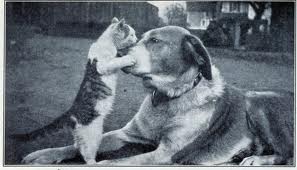
Once upon a time, there was a cat and dog boarding house nestled in the thick woods near 49th Street and 10th Avenue, in what was then the town of New Utrecht, Brooklyn, in Kings County, New York.
The kennels, advertised as the Chelmsford Stock Farm, were just a stone’s throw from Fort Hamilton Avenue (renamed Fort Hamilton Parkway in 1910), and only a few minutes’ walk from the “thickly settled” section of Borough Park. An article in the Brooklyn Daily Eagle coined the New Utrecht kennels a “Farm for City-Bred Cats” whose wealthy owners spend summers at the seashore.
The proprietor of the kennels was Frederick Webster, who owned a large, rhomboid-shaped, fenced-in lot along 10th Avenue from 49th to 51st streets. Webster operated the main branch of his Open Air Carpet Cleaning establishment on the site, and he also boarded horses in stables on the property. An 1890 Kings County map published by E. Robinson shows 11 dwellings on the property, including the carpet cleaning buildings and stables.
In the summer of 1899, 22 cats and 45 dogs were summering at Chelmsford Farm. They were all under the care of John Hughes, who had been a superintendent at the boarding facility for many years.
One of John’s most valuable assistants was a small gray and white cat, who had wandered onto the property one day and immediately made friends with all the animals. Called Plain Bill, the feline assistant proved his worth by roaming the grounds and keeping unwanted intruders away from the cages.
On August 19, 1899, a reporter from the Brooklyn Daily Eagle visited the New Utrecht kennels to check out some of the “fine feline specimens” who were boarding there, unbeknownst to most of the nearby residents and patrons on Fort Hamilton Ave. The reporter was quite pleasantly surprised by the “remarkably clean condition” and the impressive manners of the cats “who have been taught to behave themselves and to keep perfectly quiet.”
As the reporter described it, the dog kennels were located on one edge of the woods, and consisted of a house and a fenced-in area with a little door that allowed the dogs to go back and forth along an outdoor promenade. The cat kennels were located some distance from the dogs, and featured a large building with spacious cages for each feline boarder. The cats got exercise every morning and were allowed to sunbathe outdoors for a few hours each day.

On the day of his visit, several cats greeted the reporter, including Barney, belonging to Miss Cochrane of 71 Hancock Street; Dewey, a maltese owned by police captain Charles H. Bedell of the Fourth Precinct; Billy, a large maltese who resided at 630 Flatbush Avenue with Mrs. William Moore; and Teddy, belonging to Samuel Redfern of 381 Weirfield Street.

“Send Your Valuable Dogs to Chelmsford”
In a May 1891 ad for his kennels at New Utrecht, Frederick Webster invited people to send their “valuable dogs” to the Chelmsford Stock Farm before going to the country. The short classified ad stated the dogs would receive the best of care and be exercised every day. One such valuable dog that took advantage of the invitation was Lord Wilton, a prize-winning St. Bernard belonging to Mrs. Alexander Mackenzie Hughes of Amity Street, Brooklyn.
Lord Wilton, who in 1899 was listed as the oldest St. Bernard in the United States, was one of many of the St. Bernards exhibited by the New York St. Bernard Kennels, which were owned by New York newspaper mogul William C. Reick.
During the summer of 1895, Frederick Webster ran several ads announcing that the American Kennel Club stud was spending the summer at Chelmsford Farm.
Frederick Webster and the Knickerbocker Field Club
Fred Webster, the son of Michael and Mary Webster, was born in England on June 7, 1852, and arrived in New York in 1854. In 1879, Fred married Henrietta S. Merill, and the two resided at 359 Clinton Street in the Cobble Hill section of Brooklyn, which was also the official address for the offices of M. Webster’s Sons (shown above).

Fred was a very active member of the community, and was one of several prominent tennis enthusiasts who founded the Knickerbocker Field Club of Flatbush in the winter of 1889. The club was located just west of Tennis Court (love that street name!), between East 18th Street and the Brighton Beach Line of the Brooklyn, Flatbush and Coney Island Railway.
It featured six outdoor courts (plus room for three more), a small structure that served as a clubhouse, and a bowling alley behind the service lines. In 1893, a two-story clubhouse was constructed, which featured an auditorium/gymnasium and library on the main floor, director’s room and billiards room upstairs, and four bowling lanes in the basement.

Although he was still advertising his kennels at New Utrecht in 1901, by 1910 Fred was living at 101 Hillside Avenue in Glen Ridge, New Jersey. Sometime between then and 1920 he passed away: The 1920 census lists his wife as a widow who was living with their daughter, Edna.
Today, where the Chelmsford kennels and farmland once existed, are brick apartment buildings, commercial buildings, and densely packed row houses.
The Knickerbocker Field Club (or The Knick) is still in operation on East 18th Street — unbeknownst to many neighborhood visitors, but not because of thick trees: Nowadays, the outdoor tennis courts are almost completely obscured by apartment buildings and the Brighton BMT line.






